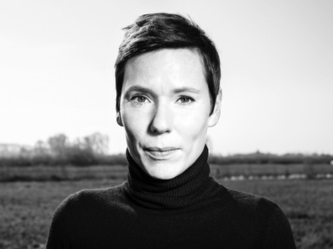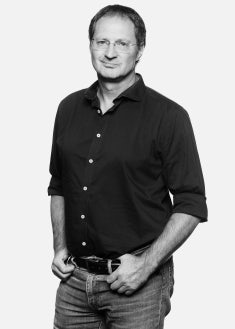Our very first Translators Week
From Monday 13 to Thursday 16 May, Flanders Literature’s very first Translators Week took place. Ten new translators from Dutch had the chance to get to know Flemish literature and by extension the language, culture and history of Flanders, with the aid of an extensive programme in which meetings with authors and their translators were central. Here you can read a general report, with links to articles that provide additional background information.

Pleasant introduction
The week began on the Monday evening in Antwerp, with a traditional and Burgundian dinner in restaurant De Lokeend. Naturally there needed to be a series of introductions. The ten translators translate into seven languages: German, English, Italian, Romanian, Spanish, Turkish and Swedish. We asked each of them to name something they regard as typically Flemish. The answers came as no surprise to us: fries, beer, chocolate, Antwerpse handjes (hand-shaped biscuits), bricks and the ‘-ke’ diminutive suffix.
On the Tuesday morning we greeted the group in Hotel Dumont along with all the staff of our international team. We told them what we do for translators and presented several titles of books that we would like to see translated:
- Children’s and youth literature: ‘Aldo and Rino’ by Jacques & Lise and ‘What We Have Left’ by Aline Sax.
- Drama: ‘Lady + Lord Macbeth’ by Tom Lanoye and ‘Wunderbaum speelt live (online gaat het mis)’ by Annelies Verbeke.
- Fiction: ‘Half a Life’ by Aya Sabi and ‘Magnificent Monster’ by Fleur Pierets.
- Graphic novels: ‘Bungalow 5’ by Maarten Vande Wiele and ‘The Drummer of Borodino’ by Simon Spruyt.
- Nonfiction: ‘Disability’ by Anaïs Van Ertvelde and ‘Pride’ by Martha Claeys.
- Poetry: ‘Zabriskie’ by Peter Verhelst and ‘Anchor, Cross, Heart’ by Sofie Verdoodt.
Willem Bongers-Dek (chair of the BoekenOverleg) and Camilla Pargentino (on the staff of the Dutch Foundation for Literature) also came to say a few words about, respectively, the Flemish literary field and the activities of our neighbours to the north.
The highpoint for me was the guided walk led by Kathleen Vereecken in combination with the viewing of the ‘Adoration of the Mystic Lamb’. I’d never heard of Margriete before, and now I can’t wait to read Kathleen’s book!Bo-Elise Brummelkamp, translator from Dutch into German
I found it very useful to gain an insight into how Flanders Literature is organized and who does what. I can now put a face to your names, so making contact is less intimidating, and I now associate Flanders Literature with real people, rather than with a big bureaucratic entity.Catalina Oslobanu, translator from Dutch into Romanian
Tears of beauty

After our lunch we were given a guided tour of the Hendrik Conscience Heritage Library, both in front of and behind the scenes. Then Annelies Verbeke, whose work has been translated into more than thirty languages, came to tell us about her diverse experiences with translators. “If there’s no contact between translator and author during the making of a translation, that doesn’t necessarily mean it will end in disaster. I deplored the fact that the Belgian translator who translated my novel ‘Thirty Days’ into French hadn’t ever asked me anything, but when Le Monde praised the style of her work, I forgave her.”

After that, Geert Sels took us with him into history and talked about his research for his book ‘Art for the Reich. In search of artworks stolen from Belgium by the Nazis.’ “The situation in Belgium is as black as Malevich’s painting. It wasn’t my intention to write a book, but one article quickly grew into a series of articles and so the ball started rolling. I found many documents in the archives about people who were robbed and I thought: This mustn’t simply be a dead letter. This mustn’t just be left in the archives.”
After the two inspiring talks, we headed into town with the translators for a walk through the historic centre, where Joris took the opportunity to present ‘The Smells of the Cathedral’ by Wendy Wauters. There was also time for a visit to bookshop ’t Stad leest.
The visit to the Heritage Library was so overwhelmingly beautiful that it immediately brought tears to my eyes. I also very much enjoyed visiting the Translators House in Antwerp and hope to come back for a longer stay to translate a Flemish title into German.Christine Koopmann, translator from Dutch into German
The best moments were the informal ones, in which you could talk with people who share your passion for literature and language, and also your struggles. Free time together and meals are perfect for building a network of colleagues and friends, and you did a great job of providing us with those!Carmen Clavero Fernández, translator from Dutch into Spanish
Faith in the world
The next morning our train left early for Ghent. We first called at Ghent University, where Professor Doctor Anne-Sophie Ghyselen (co-author of ‘Atlas of the Dialect in Flanders’) gave us a few words of explanation about the history of the Flemish language. Then Kathleen Vereecken was waiting to meet us and to take us for a walk through the historic centre of town, where she told us in colourful detail about the history of the Van Eyck family and especially about Margareta Van Eyck, the subject of her wonderful book ‘Margriete’. The walk ended at the astonishing altarpiece ‘Adoration of the Mystic Lamb’ in Saint Bavo’s Cathedral.

In the afternoon, illustrator Tom Schamp engaged in a discussion with his translator into French, Noëlle Michel, followed by poet Miriam Van hee with her translator into French, Philippe Noble. This resulted in two truly excellent conversations about their work and collaboration, and also about the specific challenges involved in the translation of illustrated children’s books and of poetry.
I create pictures. While I’m painting, words come to the surface. They prompt many associations in various languages. As a boomer in a garden in Brussels, I think up something that a young Japanese child will enjoy. That’s crazy, isn’t it? It gives you faith in the world.Tom Schamp, illustrator
When you’re translating you have less freedom than when you write. With Tom’s book you’re tied to the drawings, but that means you can take a bit of distance from the text. Tom’s work requires a lot of creativity. When I’m translating it, I feel like a small child, playing.Noëlle Michel, translator from Dutch into French

Music is important to me. I don’t look for rhymes, but I do look for a rhythm. If a word doesn’t fit in that rhythm, it won’t be allowed to stay. A different word will come along and it will astonish me: yes, this works.Poet Miriam Van hee
Translation is my way of to some extent creating literature.Philippe Noble, translator from Dutch into French

Graphic novels and debuts
We started the final day with typical Belgian weather and arrived at bookshop De Groene Waterman dripping wet. There comic book author Michaël Olbrechts and his translator into French Laurent Bayer were interviewed together, by journalist Kurt Snoeckx. During the conversation they looked in detail at the grant for sample translations, an arrangement that Laurent enjoys drawing upon. “That grant obliges you as a translator to draw up a promotion plan. By actively promoting the book and the translation, I’ve come into contact with publishers and other professionals in the book trade, which has brought me further work.”

Next we listened to two debut authors, Tiemen Hiemstra and Sabrine Ingabire, who were interviewed by journalist Katrien Steyaert about their books ‘W.’ and ‘Companions in Fate’. They inspired not only the audience but each other, too, and promised to read each other’s books.
For me, writing is something very spiritual, it’s a way of touching upon how remarkable our existence is. W. has an immense hunger to experience everything. He doesn’t want to be one person but to lead several lives, which also ensures that he makes radical choices. I wanted to investigate that.Author Tiemen Hiemstra
A few years ago I was asked whether I might consider writing a book about what it’s like to grow up in Flanders as a Black woman. I didn’t really want to do that, because I found it too great a responsibility. I don’t want to be a role model, nor to write the Black story of Flanders, because there’s no such thing.Author Sabrine Ingabire

In the afternoon, a visit to the KMSKA was on the programme, under the professional guidance of Koenraad Jonckheere, author of the extensive reference work ‘Another History of Art’. After that we visited the Translators House, where the versatile Maud Vanhauwaert playfully took us through her oeuvre and showed us the projects she has completed over the past few years. Gea Schelhaas of the Expertisecentrum Literair Vertalen (ELV) also came to give a presentation, and she shed light on opportunities to apply for a mentorship or a development programme. We concluded the week with a delicious dinner at Humm on the Dageraadplaats.

For me, the personal contacts were the most important. And I now have a clear picture of the ways in which, as a translator, I can ask for help. Translators don’t earn very much, so it’s important to know what resources you might be entitled to.Shimanto Reza, translator from Dutch into English